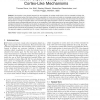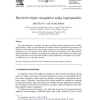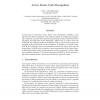PAMI
2007
14 years 6 months ago
2007
—We introduce a new general framework for the recognition of complex visual scenes, which is motivated by biology: We describe a hierarchical system that closely follows the orga...
NN
2002
Springer
14 years 6 months ago
2002
Springer
Recognition-by-components is one of the possible strategies proposed for object recognition by the brain, but little is known about the low-level mechanism by which the parts of o...
CVIU
2004
14 years 6 months ago
2004
This paper proposes a technique for object recognition using superquadric built models. Superquadrics, which are three-dimensional models suitable for part-level representation of...
TIP
2008
14 years 6 months ago
2008
We consider the problem of recognizing 3-D objects from 2-D images using geometric models and assuming different viewing angles and positions. Our goal is to recognize and localize...
IJNS
2007
14 years 6 months ago
2007
We present a biologically motivated architecture for object recognition that is capable of online learning of several objects based on interaction with a human teacher. The system...
NN
2008
Springer
14 years 6 months ago
2008
Springer
We present a biologically motivated architecture for object recognition that is based on a hierarchical feature-detection model in combination with a memory architecture that impl...
KI
2006
Springer
14 years 6 months ago
2006
Springer
In this paper we introduce Active Monte Carlo Recognition (AMCR), a new approach for object recognition. The method is based on seeding and propagating "relational" part...
ICANN
2010
Springer
14 years 7 months ago
2010
Springer
Abstract. A common practice to gain invariant features in object recognition models is to aggregate multiple low-level features over a small neighborhood. However, the differences ...
ECCV
2010
Springer
14 years 8 months ago
2010
Springer
Abstract. Domain adaptation is an important emerging topic in computer vision. In this paper, we present one of the first studies of domain shift in the context of object recogniti...
CCIA
2009
Springer
14 years 8 months ago
2009
Springer
General object recognition in mobile robots is of primary importance in order to enhance the representation of the environment that robots will use for their reasoning processes. T...



